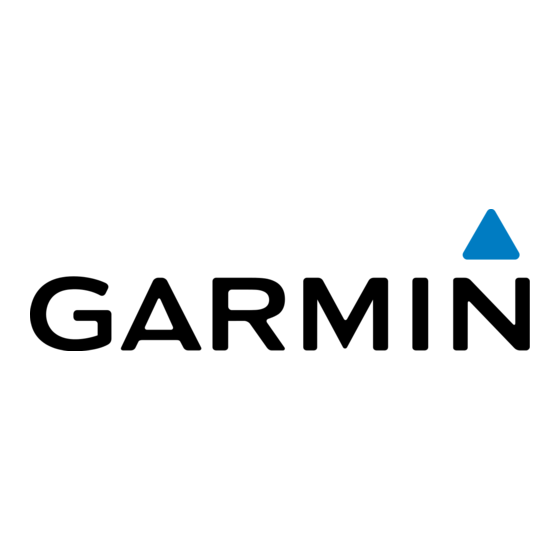- ページ 28
船舶用GPSシステム Garmin nuvi 500-SeriesのPDF オーナーズマニュアルをオンラインで閲覧またはダウンロードできます。Garmin nuvi 500-Series 44 ページ。 Flush mount template
Garmin nuvi 500-Series にも: クイック・リファレンス・マニュアル (2 ページ), ユーザーマニュアル (28 ページ), オーナーズマニュアル (38 ページ), 重要なお知らせ (1 ページ), 取付説明書 (6 ページ), オーナーズマニュアル (50 ページ)

When an engine alarms is triggered, a gauge status alarm
message appears and the gauge may become red depending
on the type of alarm.
Enabling Some Engine Gauge Status Alarms
1
From the engine gauges screen, select Menu > Gauge
Setup > Status Alarms > Custom.
2
Select one or more engine gauge alarms to turn on or off.
Selecting the Number of Engines Shown in Gauges
You can show information for up to four engines.
1
From the engine gauges screen, select Menu > Gauge
Setup > Engine Selection > Num. Engines.
2
Select an option:
• Select the number of engines.
• Select Auto Configure to automatically detect the
number of engines.
Customizing the Engines Shown in Gauges
Before you can customize how the engines are shown in the
gauges, you must manually select the number of engines
(Selecting the Number of Engines Shown in
1
From the engine gauges screen, select Menu > Gauge
Setup > Engine Selection > Edit Engines.
2
Select First Engine.
3
Select the engine to display in the first gauge.
4
Repeat for the remaining engine bars.
Configuring the Fuel Gauges Display
Before you can configure and display the fuel levels, you must
connect a compatible engine, fuel flow sensor, or tank level
sensor to the NMEA 2000 network.
You can display the total amount of fuel on-board either as a
numeric display that shows the total fuel or as a graphic display
that shows the level in each fuel tank.
1
Select Gauges > Engine > Menu > Gauge Setup > Fuel
Display.
2
Select an option:
• To display the total fuel level in all tanks, select Use Total
Fuel Onboard.
• To display the amount of fuel in each tank, select Use
Fuel Tank Levels.
Setting the Fuel Capacity of the Vessel
1
Select Settings > My Vessel > Fuel Capacity.
2
Enter the combined total capacity of the fuel tanks.
Synchronizing the Fuel Data with the Actual Vessel
Fuel
You can synchronize the fuel levels in the chartplotter with the
actual fuel in the vessel when you add fuel to your vessel.
1
Select Gauges > Engine > Menu.
2
Select an option:
• After you have filled up all the fuel tanks on the vessel,
select Fill Up All Tanks. The fuel level is reset to
maximum capacity.
• After you have added less than a full tank of fuel, select
Add Fuel to Boat, and enter the amount added.
• To specify the total fuel in the vessel tanks, select Set
Total Fuel Onboard, and enter the total amount of fuel in
the tanks.
Setting the Fuel Alarm
Before you can set a fuel level alarm, a compatible fuel flow
sensor must be connected to the NMEA 2000 network.
22
You can set an alarm to sound when the total amount of
remaining onboard fuel reaches the level you specify.
1
Select Settings > Alarms > Fuel > Fuel Alarm > On.
2
Enter the remaining amount of fuel that triggers the alarm.
Viewing the Wind Gauges
Before you can view wind information, you must have a wind
sensor connected to the chartplotter.
Select Gauges > Wind.
Configuring the Sailing Wind Gauge
You can configure the sailing wind gauge to show true or
apparent wind speed and angle.
1
From the wind gauge, select Menu > Sailing Wind Gauge.
2
Select an option:
• To show true or apparent wind angle, select Needle, and
• To show true or apparent wind speed, select Wind
Gauges).
Configuring the Speed Source
You can specify whether the vessel speed data displayed on
the gauge and used for wind calculations is based on water
speed or GPS speed.
1
From the wind gauge, select Menu > Compass Gauge >
Speed Display.
2
Select an option:
• To calculate the vessel speed based on data from the
• To calculate the vessel speed based on GPS data, select
Configuring the Heading Source of the Wind Gauge
You can specify the source of the heading displayed on the
wind gauge. Magnetic heading is the heading data received
from a heading sensor, and GPS heading is calculated by your
chartplotter GPS (course over ground).
1
From the wind gauge, select Menu > Compass Gauge >
Heading Source.
2
Select GPS Hdg or Magnetic.
NOTE: When moving at low speeds or when stationary, the
magnetic compass source is more accurate than the GPS
source.
Customizing the Close-Hauled Wind Gauge
You can specify the range of the close-hauled wind gauge for
both the upwind scale and the downwind scale.
1
From the wind gauge, select Menu > Compass Gauge >
Set Gauge Type > Close Hauled Gauge.
2
Select an option:
• To set the maximum and minimum values that appear
• To set the maximum and minimum values that appear
• To view true or apparent wind, select Wind, and select an
Viewing the Environment Gauges
Select Gauges > Environment.
Configuring the Alignment of the Wind Gauge
You can specify the alignment of the wind gauge on the
environment gauges.
1
Select Gauges > Environment > Menu > Alignment.
select an option.
Speed, and select an option.
water-speed sensor, select Water Speed.
GPS Speed.
when the upwind close-hauled wind gauge appears,
select Change Upwind Scale, and set the angles.
when the downwind close-hauled wind gauge appears,
select Change Downwind Scale, and set the angles.
option.
Gauges and Almanac Information
